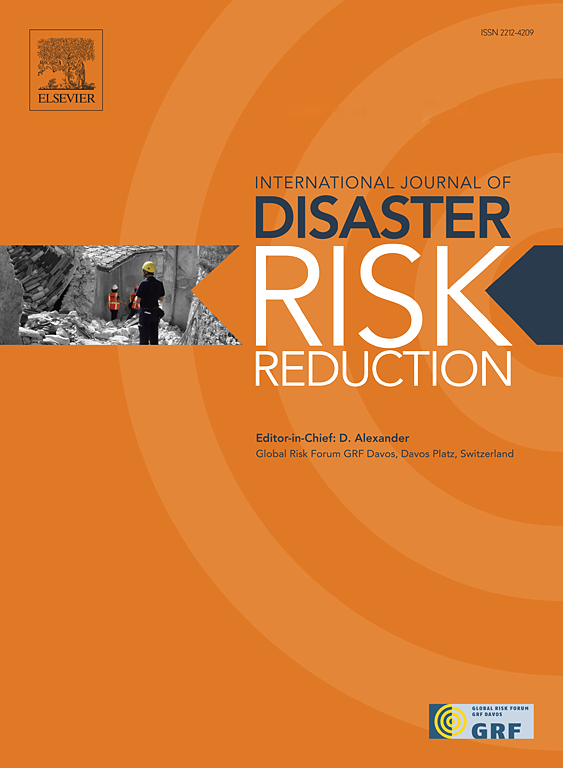洪水和下沉灾害综合评估:减轻风险和水可持续性的战略方针
IF 4.5
1区 地球科学
Q1 GEOSCIENCES, MULTIDISCIPLINARY
International journal of disaster risk reduction
Pub Date : 2025-04-15
DOI:10.1016/j.ijdrr.2025.105429
引用次数: 0
摘要
莫雷利亚市自16世纪建城以来就经历了洪水,自1983年以来地面下沉。虽然这两种现象传统上都是独立研究的,但最近的研究表明,下沉是更严重洪水的一个条件因素。该研究通过综合方法分析了沉降-洪水相互作用,将从SAR数据中得出的沉降情景与水动力洪水模型(FLO-2D)相结合。沉降场景使用InSAR数据集,并通过修改高分辨率LiDAR DTM来表示当前和未来的沉降情况。FLO-2D模型结合了现有的城市布局和预计的发展,以评估城市化的影响。区域洪水模拟表明,在当前条件下,考虑到50年一次的降雨事件,近64%的莫雷利亚地区受到一定程度的洪水影响。对地表沉降率最高的三个区域进行了详细分析。在所有情况下,与目前相比,未来沉降情景下洪水灾害变量增加。此外,当考虑到预测的城市扩张时,结果表明城市规划不足加剧了沉降-洪水现象。城市化阻碍了自然排水路径,增加了水流的速度,减少了水力面积。此外,城市扩张引起了级联效应,将径流重新定向到邻近的社区。这种综合方法为理解下沉-洪水现象提供了有价值的工具,并支持绿色基础设施解决方案的设计,在气候变化背景下促进可持续和有弹性的城市发展。本文章由计算机程序翻译,如有差异,请以英文原文为准。

Integrated assessment of flood and subsidence hazards: A strategic approach for risk mitigation and water sustainability
The city of Morelia has experienced flooding since its founding in the 16th century and land subsidence since 1983. Although both phenomena have traditionally been studied independently, recent research suggests that subsidence acts as a conditioning factor for more severe flooding. This study analyzes the subsidence-flooding interaction through an integrated approach, combining subsidence scenarios derived from SAR data with a hydrodynamic flood model (FLO-2D). Subsidence scenarios were generated using InSAR datasets and by modifying a high-resolution LiDAR DTM to represent both present and future subsidence conditions. The FLO-2D model incorporated the existing urban layout and projected developments to assess the influence of urbanization. Regional flood modeling indicates that under current conditions, nearly 64 % of Morelia is subject to some degree of flooding when considering a 50-year return period rainfall event. A detailed analysis was conducted for three sectors exhibiting the highest subsidence rates. In all cases, flood hazard variables increased under the future subsidence scenario compared to the present. Moreover, when accounting for the projected urban expansion, results indicate that inadequate urban planning exacerbates the subsidence-flooding phenomenon. Urbanization contributes to flow accumulation by obstructing natural drainage paths and increases flow velocities due to the reduction of hydraulic areas. Additionally, urban expansion induces a cascading effect, redirecting runoff toward adjacent neighborhoods. This integrated approach provides a valuable tool for understanding the subsidence-flooding phenomenon and supports the design of green infrastructure solutions that foster sustainable and resilient urban development in the context of climate change.
求助全文
通过发布文献求助,成功后即可免费获取论文全文。
去求助
来源期刊

International journal of disaster risk reduction
GEOSCIENCES, MULTIDISCIPLINARYMETEOROLOGY-METEOROLOGY & ATMOSPHERIC SCIENCES
CiteScore
8.70
自引率
18.00%
发文量
688
审稿时长
79 days
期刊介绍:
The International Journal of Disaster Risk Reduction (IJDRR) is the journal for researchers, policymakers and practitioners across diverse disciplines: earth sciences and their implications; environmental sciences; engineering; urban studies; geography; and the social sciences. IJDRR publishes fundamental and applied research, critical reviews, policy papers and case studies with a particular focus on multi-disciplinary research that aims to reduce the impact of natural, technological, social and intentional disasters. IJDRR stimulates exchange of ideas and knowledge transfer on disaster research, mitigation, adaptation, prevention and risk reduction at all geographical scales: local, national and international.
Key topics:-
-multifaceted disaster and cascading disasters
-the development of disaster risk reduction strategies and techniques
-discussion and development of effective warning and educational systems for risk management at all levels
-disasters associated with climate change
-vulnerability analysis and vulnerability trends
-emerging risks
-resilience against disasters.
The journal particularly encourages papers that approach risk from a multi-disciplinary perspective.
 求助内容:
求助内容: 应助结果提醒方式:
应助结果提醒方式:


